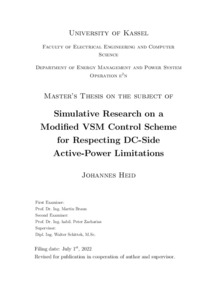| dc.date.accessioned | 2022-09-05T13:28:45Z | |
| dc.date.available | 2022-09-05T13:28:45Z | |
| dc.date.issued | 2022 | |
| dc.identifier | doi:10.17170/kobra-202208306782 | |
| dc.identifier.uri | http://hdl.handle.net/123456789/14130 | |
| dc.language.iso | eng | |
| dc.rights | Urheberrechtlich geschützt | |
| dc.rights.uri | https://rightsstatements.org/page/InC/1.0/ | |
| dc.subject | asymmetric inertia | eng |
| dc.subject | unidirectional inertia | eng |
| dc.subject | instantaneous reserve | eng |
| dc.subject | charging infrastructure | eng |
| dc.subject | electric vehicle | eng |
| dc.subject | virtual synchronous machine | eng |
| dc.subject | synchronous converter | eng |
| dc.subject.ddc | 620 | |
| dc.title | Simulative Research on a Modified VSM Control Scheme for Respecting DC-Side Active-Power Limitations | eng |
| dc.type | Masterarbeit | |
| dcterms.abstract | This thesis presents and examines a novel approach to modify the active-power behaviour of a generic virtual synchronous machine (VSM) in order to respect DC-side active-power limitations of converter-coupled generation and loads, thereby enabling them to participate in instantaneous reserve without hardware reinforcements.
A modification to the VSM control is suggested, which consists of a ∆P feedback loop and a dynamic adaptation of the virtual impedance Xvirt. These mechanisms enable the VSM to have a RoCoF-dependent (Rate of Change of Frequency) acceleration time constant TA ≥ 0 without endangering the system stability for low values of TA. These mechanisms are able to keep the active power of the VSM within parameterizable limits and act a lot faster than a method previously suggested in research.
Three operation modes for a modified VSM are realised: unidirectional where a VSM contributes to instantaneous reserve for only one RoCoF direction, bidirectional where a VSM contributes to instantaneous reserve in both directions but with different strengths, and deactivated where a VSM does not contribute to instantaneous reserve at all but still uses the VSM control scheme.
To demonstrate the feasibility of the modified control, four test cases are simulated in Matlab/Simulink. Results show that the VSM behaves as expected and that it is operated within its specified active-power limits except for a short duration when a sudden disturbance occurs.
The energy of the active-power peak shortly violating the parameterized active-power limit in the system-split scenario is utilized as a performance indicator. An exemplary calculation shows that the impact of this peak on the voltage of a DC-link capacitor does not exhaust common security margins and therefore does not imperil the basic functionality of the converter. Furthermore, the sensitivity of the performance indicator with respect to four central parameters is investigated. It is found that the parameterisation used for simulations throughout this thesis is a good compromise between minimizing the performance indicator and optimising stability. | eng |
| dcterms.accessRights | open access | |
| dcterms.creator | Heid, Johannes | |
| dcterms.dateAccepted | 2022-07-01 | |
| dcterms.extent | VII, 116 Seiten | |
| dc.contributor.corporatename | Kassel, Universität Kassel, FB16 Elektrotechnik/Informatik | ger |
| dc.contributor.referee | Zacharias, Peter (Prof. Dr.) | |
| dc.contributor.referee | Schittek, Walter | |
| dc.contributor.referee | Braun, Martin (Prof. Dr.) | |
| dc.relation.projectid | PtJ FKZ 0350023C and 0350048D | |
| dc.subject.swd | Trägheit | ger |
| dc.subject.swd | Elektrofahrzeug | ger |
| dc.subject.swd | Elektromobilität | ger |
| dc.subject.swd | Technische Infrastruktur | ger |
| dc.subject.swd | Ladegerät | ger |
| dc.subject.swd | Elektrotechnik | ger |
| dc.subject.swd | Synchronmaschine | ger |
| dc.type.version | publishedVersion | |
| kup.iskup | false | |

